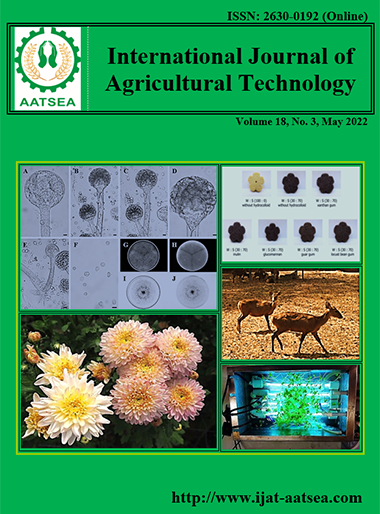Application of organic soybean tempeh in purple sweet potato raisin cookie
Main Article Content
Abstract
Organic soybean tempeh or tempeh kedelai is made by fermentation with Rhizopus oligosporus was used to produce cookies, as a plant-based protein snack. Four samples with various recipes - purple sweet potato cookie, purple sweet potato raisin cookie, tempeh purple sweet potato cookie and tempeh purple sweet potato raisin cookie – were prepared to determine the physicochemical and sensory features. Chemical analysis found that the tempeh purple sweet potato raisin cookie has the highest moisture (18%) and total proteins (29%). However, the purple sweet potato cookies showed the highest ashes content (2%) and tempeh purple sweet potato cookie showed the highest total lipids (29%). The tempeh purple sweet potato raisin cookie was hardest (61 N). The tempeh purple sweet potato raisin cookie had the highest scores for food acceptability of all qualities in appearance, texture, aroma, colour, taste and general acceptability using a 9-point hedonic scale ranging from slightly liked to very much liked. Therefore, the tempeh purple sweet potato raisin cookie can be accepted as a new snack, that includes a good level of protein and thus a healthy food alternative. Furthermore, if all steps of the production are carefully controlled by USDA or other certifying bodies, thus this product may be labelled as organic product.
Article Details

This work is licensed under a Creative Commons Attribution-NonCommercial-NoDerivatives 4.0 International License.
References
Ahnan-Winarno, A. D., Cordeiro, L., Winarno, F. G., Gibbons, J. and Xiao, H. (2020). Tempeh: A semicentennial review on its health benefits, fermentation, safety, processing, sustainability, and affordability. Comprehensive Reviews In Food Science And Food Safety, 20:1717-1767.
Angulo-Bejarano, P. I., Verdugo-Montoya, N. M., Cuevas-Rodríguez, E. O., Milán-Carrillo, J., Mora-Escobedo, R., Lopez-Valenzuela, J. A., Garzón-Tiznado, J. A. and Reyes-Moreno, A. (2008). Tempeh flour from chickpea (Cicer arietinum L.) nutritional and physicochemical properties. Food Chemistry, 106:106-112.
AOAC. (2000). The Association of Official Agricultural Chemists, seventeenth ed. Official Method of Analysis, Washington, DC, USA.
Codex Alimentarius Guo, M. (2009). Soy food products and their health benefits functional foods. In: Functional foods principles and technology, Cambridge, England, pp.237-277.
Erkan, A. B., Gürler, H. N., Bilgin, D. G., Germec, M. and Turhan, I. (2020). Production and characterization of tempehs from different sources of legume by Rhizopus oligosporus. LWT - Food Science and Technology, 119:1-7.
Everitt, M. (2009). Consumer-Targeted Sensory Quality. In: Global Issues in Food Science and Technology, Burlington, USA, pp. 117-128.
Food and Agriculture Organization-World Health Organization. (2017). Regional standard for tempe. Rome, Italy: FAO-WHO.
Gandjar, I. (1999). FERMENTED FOODS | Fermentations of the Far East. Encyclopedia of Food Microbiology, 767-773.
Handoyo, T. and Morita, N. (2006). Structural and functional properties of fermented soybean (tempeh) by using Rhizopus oligosporus. International Journal of Food Properties, 9:347-355.
Nout, M. J. R. and Kiers, J. L. (2005). Tempe fermentation, innovation and functionality: update into the third millennium. Journal of Applied Microbiology, 98:789-805.
Shurtle, W. and Aoyagi, A. (2020). History of tempeh and tempeh products (1815-2020): extensively annotated bibliography and sourcebook. Soyinfo Center, Lafayette, USA, pp. 1-1416.


